1/32 Tamiya Mitsubishi A6-M5 Zero
I bought this model in Paris a few years ago at a really cool hobby shop on the Left Bank. Don't know why I bought because I could have purchased it here in the States for less.
Anyway, it's built straight out of the box. I used the hairspray technique over Alclad aluminum, pre-shaded, and a custom mix of Tamiya paint over that. The first time I tried that, it turned out too symmetrical and predictable looking so I gave the model a bath in Mr Color paint thinner and washed all the paint off and started over. It's really easy to over-do it so I had to be really careful, patient, and persistent. It's not my best effort, but it turned out okay. Tamiya kits are so beautifully engineered (and expensive) that I get a little nervous building them. I almost prefer a mediocre kit that requires a lot of sanding, filling and swearing. Building them is more gratifying to me because of the extra effort that goes into them.
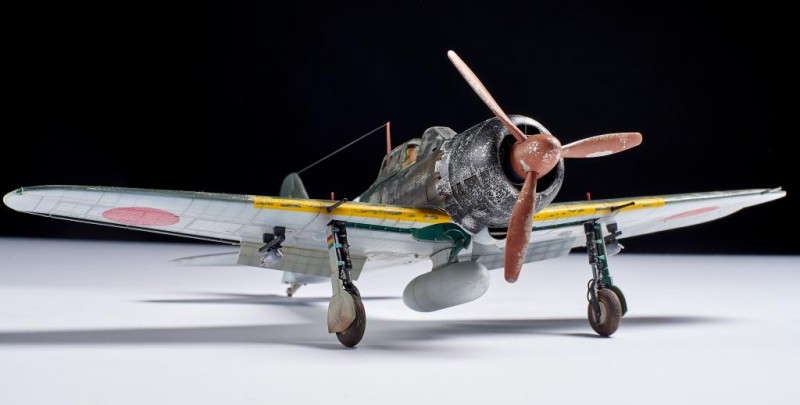
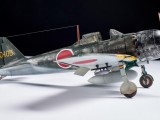

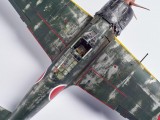

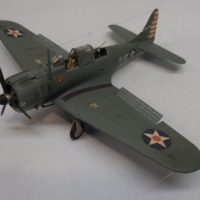

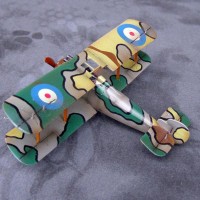
Nice build !
"chiping" is owerdone ?*
Thanks. No, these planes were usually painted in the field using low quality paints so they faded and chipped very easily. Some examples show very little paint left on them. It just depends on which photographs you use as references.
It appears perhaps you overlooked the same thing I did on mine. The red walk-way areas and the national insignia should have received the same weathering treatment as the rest of the airframe. Sometimes we (at least I) do a bang-up job on the paint scheme and THEN apply decals, forgetting that ALL the paint should be worn.
BUT...the argument could be made that the ground crew took pride in their country and re-painted the red circles (and the flap areas). Jus' sayin'...
The Hinomarus were generally maintained by the ground crews and I debated weathering them or not, but in the end decided that I was bored with this thing and moved on.
I thought that might indeed be the case...I see the yellow leading edges were chipped. 🙂
It's amazing to see the thousands of variations on these things that modeler's produce, and everybody has their opinion on it. I try to take a more informal approach and not go nuts on all the historical and technical details. I'm not building for museums so I'll often mix insignias, serial numbers, and placards in order to achieve the effect that I want. I've been criticized for stupid things like not having properly flattened tires or landing gear that's not fully extended on a hovering V-22, etc., but there's a point where it stops being fun if it has to be 100% accurate. I don't get enjoyment from that.
George, nitpickers pick nits, that's what they do.
Nicely done. I have solved the "expensive kit" fear by mostly buying large lots on ebay - which are usually older kits, and of course dirt cheap when purchased that way! I really enjoy taking old kits and trying to make something presentable out of them, although I don't go for "correcting" shape mistakes as much as just getting something presentable that is a solid representation. It almost takes all the fun out of it when you purchase a high-quality new kit and there's nothing to fix!
I absolutely agree with you. I usually feel compelled to correct mistakes and that's part of the fun.
According to the Osprey book on building Zero models, at least early on, Zeroes had overall red primer then the paints were applied. There was a photo of the remains of one in the book, and the primer was still on it, even after all this time. End of war, all bets were off.
This looks like A6M5A, fighterbomber. The upsweep of the underside gray on the rear fuselage reputedly is a clue that its Nakajima built.
The variables in weathering (IMHO) would depend on location, time frame. Another concern would be when photographed, as some of that was done postwar, in aircraft graveyards, probably before all were shoved into a pile and burned.
Cool.
George, meant to tell you, that first picture is stunning! Whatta plane, even if it's the other sides.
Thanks, Bernard. I appreciate the info on the Zero, too.
Outstanding lookind Zero. I like the weathering
Tom
Arguably the finest Zero kit. You've done a nice job, too, as noted.
Zeros in later war years were sprayed green over bare metal, and as soon as the metal heated up or became abraded with wind-blown sand, the paint began to break down. Hinomarus had a different, higher quality paint that didn't succumb to the elements so readily.
Of course the easiest way to resolve the main walkway markings is to mask and paint, and then treat as other finishes for natural wear. The salt method us also useful in this respect, I've found.
Thanks, Rob. I've used the salt method with outstanding results. I'll post a photo of the Tamiya Swordfish I built a few years back.
That's a great Zero, George. I like your more rubbed down sort of wear compared to normal chipping.